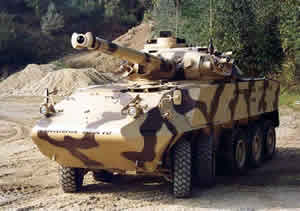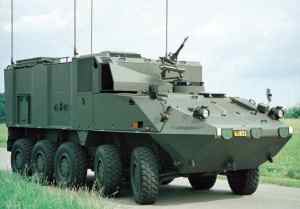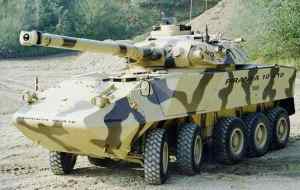| Designation: | Piranha III 10x10 |
 |
|---|---|---|
| Manufacturer: | General Dynamics European Land Systems-Mowag GmbH | |
| Product type: | Armoured Vehicles | |
| Name: | Reconnaissance Vehicle |
Development of the Piranha (10 × 10) Armoured Combat Vehicle (ACV) commenced in December 1992 with the decision to build a prototype vehicle taken in April 1993. The vehicle was developed by MOWAG specifically for the export market.
Development of the MOWAG Piranha (10 × 10) vehicle was completed late in 1994 and early in 1995 went to the Middle East for customer demonstrations. This vehicle was fitted with the French now Nexter Systems (previously Giat Industries) TML 105 turret armed with a 105 mm gun.
During the development programme, some 100 rounds of 105 mm ammunition were fired, including some with the turret traversed at 90° left and right and on an inclined position. Mobility trials covered over 7,500 km on both road and cross-country terrain.
While the MOWAG Piranha (8 × 8) is suitable for most requirements, the new 10 × 10 version gives an increase in payload, a larger internal volume and enhanced ballistic protection. It retains the same high degree of mobility as the earlier 8 × 8 vehicles.
According to MOWAG, the new five-axle configuration offers the following advantages:
- Redundancy of drive assemblies in the case of a drive assembly failure due to combat damage
- High cross-country mobility with crew comfort
- Minimal vehicle width for air-transportability (the 10 × 10 model is air-portable in a Lockheed Martin C-130)
- Enhanced crew protection against mines
- Increased protection against direct fire
Sweden is the first customer for the MOWAG Piranha (10 × 10) ACV with the first order being for three vehicles, two in the Armoured Command Vehicle (ACV) configuration and the third in the Armoured Sensor Vehicle (ASV) radar carrier configuration.
The first of these vehicles was handed over in mid-1997 followed by the second in September 1997. This was followed by the ASV which has an extendable mast, also developed by MOWAG on which the surveillance and target radar is mounted. The vehicles were fitted out with an extensive suite of C3I equipment in Sweden.
For its specialised mission, the MOWAG Piranha ACV has a number of modifications including a raised rear roof for increased internal volume and a 40 kW auxiliary power unit developed and tested by MOWAG as part of the contract with the Swedish Defence Matériel Administration.
The commander's position, to the rear of the driver on the left side is provided with an externally mounted 7.62 mm machine gun.
Late in 1997, Sweden exercised its second option and placed a contract with MOWAG for a further five ACV (10 × 10) vehicles in ACV configuration. These vehicles were equipped with a 340 hp Scania diesel engine coupled to a ZF seven-speed fully automatic transmission.
In August 2000, MOWAG, which today is part of General Dynamics Corporation - European Land Combat Systems, was awarded another contract by the Swedish Defence Material Administration. This was for the supply of a further five MOWAG Piranha IIIC (10 × 10) Armoured Sensor Vehicles (ASV) for use by the Swedish Amphibious Brigade.
These ASV were delivered to Sweden in 2002 where the new Ericsson Microwave Systems Giraffe AMB (Agile Multi-Beam) radars were integrated, these have already been ordered under a separate contract. The C in the designation indicates that the vehicle has a conventional independent suspension system.
It was originally expected that Sweden would order a total of 44 MOWAG Piranha IIIC (10 × 10) vehicles, in the ASV and 17 in the ACV configuration. This requirement has now been cut back and it is probable that the latest order received by MOWAG will be the last.
It was also expected that Sweden would order 18 Armoured Escort Vehicles (AEV) in 8 × 8 configuration fitted with a turret to provide cover for the ASC and ACV versions, but this option was never exercised. One Piranha III (8 × 8) in the APC role was supplied to Sweden in 2002.
The all-welded steel hull of the original MOWAG Piranha (8 × 8) vehicle provides protection against 7.62 mm small arms fire but the new 10 × 10 version has protection against 14.5 mm small arms fire over the frontal arc. Spall liners can be added to the crew compartment to provide additional protection from splinters.
The layout of the vehicle is similar to other members of the MOWAG Piranha family with the driver front left, power pack to his right and turret in the centre. The rear compartment holds 26 rounds of 105 mm ammunition, the self-recovery winch and the fuel tank.
The driver has a single-piece hatch cover that opens to the left rear and in front of this are three day periscopes, the centre one of which can be replaced by a passive periscope for night driving. The driver's seat is fully adjustable. On the prototype there is an additional seat and hatch cover to the immediate rear of the driver.
The prototype was originally fitted with the Giat Industries (now Nexter Systems) 105 TML power-operated turret armed with a 105 mm G2 rifled gun capable of firing standard NATO ammunition natures, including APFSDS (Armour-Piercing Fin-Stabilised Discarding Sabot) with a muzzle velocity of 1,495 m/s.
The commander is seated on the right, with the gunner forward and below his position, and has a single-piece hatch cover that opens to the rear. The loader is seated on the left side of the turret and also has a single-piece hatch cover that opens to the rear.
A 7.62 mm machine gun is mounted coaxial with the main armament and a GALIX grenade launching system is fitted as standard. Turret traverse and weapon elevation are electrohydraulic with manual back-up.
The fire-control system includes a digital gunner's day/thermal sight with a laser range-finder, a ballistic computer and a control panel. The vehicle commander has nine HL 69 day periscopes for all-round observation and a day/night image intensification sight. The gunner also has two M336 day periscopes while the loader has three M223 day periscopes.
The current TML turret is not provided with a stabilisation system for the 105 mm gun but has now been developed and would allow the 105 mm main armament to be laid and fired with a high first round hit probability when the vehicle is moving. A load assist device is also to be developed to enable rate of fire to be increased to 8 rds/min.
Steering is power assisted on the front four road wheels with the rear three axles being permanently driven. The two front axles can be engaged when required. The 10 × 10 version has greater mobility as well as providing a more stable firing platform.
The new 10 × 10 vehicle shares many common components with the MOWAG Piranha family of armoured vehicles.
Communications equipment depends on the user but the prototype has two Thales VHF 50 W Jaguar frequency-hopping radios and an intercom system for all four crew members.
A number of options have already been developed and tested for the MOWAG 10 × 10 vehicle including:
- Larger tyres size 335/80 × 20 or 375/70 × 20
- Central tyre-pressure regulation system that allows the driver to adjust the tyre pressure to suit the ground being crossed from his seat. Three different settings are possible (on road, off road and soft ground) and a warning lamp will alert the driver as soon as the travelling speed becomes excessive for the selected tyre pressure
- New power pack consisting of an MTU diesel developing 400 hp (with growth potential to 450 hp) coupled to a fully automatic ZF six-speed automatic transmission
- Additional passive armour for the turret and hull for improved ballistic protection
- Hydropneumatic suspension for greater cross-country mobility which allows the driver to set one of three different ground clearances
Various specialised equipment can be fitted including a Rotzler winch with a capacity of 8 tonnes which is installed in the rear of the hull and can be used to the front or rear, NBC system of the overpressure or ventilated face mask type and a 10 kW air conditioning system.
The main drawback of the first generation TML 105 turret is that, as the 105 mm weapon and its associated sights are not stabilised, the vehicle has to come to halt in order to engage moving targets.
The company has now developed a new version of the 105 TML 105 mm turret which allows the system to engage stationary and moving targets while it is stationary or moving with a high first round hit probability.
This version of the 105 TML 105 mm turret integrates an electrical two-axis stabilised turret drive system, a roof-mounted gunner's sight which is also two-axis stabilised with day and thermal channels. The stabilised sight has already been proven in a number of other applications and has already demonstrated a high level of hit probability when firing on the move.
The commander's station has a removable modular cupola which, in its standard version, is fitted with a panoramic non-stabilised day sight.
As an option this can be replaced by a panoramic two-axis stabilised sight with day/thermal cameras so giving the system a hunter/killer capability similar to that fitted to the latest generation main battle tanks.
In addition, the commander and gunner sights can be fitted with an automatic target tracking system. A semi-automatic loader for the 105 mm gun is fitted.
A 7.62 mm machine gun is mounted coaxial with the main armament and, if required, a 7.62 mm machine gun provided with a shield can be installed on the roof and operated by the commander. A total of 14 GALIX grenade launchers are mounted around the turret and these can fire a variety of grenades such as smoke, decoy and fragmentation.
The turret is of all-welded construction and in its basic version provides protection against small arms fire up to 14.5 mm but, if required, a higher level of protection can be provided.
Another option for this turret is the installation of a Battle Management System (BMS) at the commander's station.
Although the prototype of the MOWAG Piranha (10 × 10) is fitted with the TML 105 105 mm turret, a wide range of other variants are possible including:
- Thales Blazer air defence turret with 25 mm cannon and MDBA Mistral SAMs
- BAE Systems Bofors 40 mm L/70 turret (as installed on all production CV9040 ICV for the Swedish Army)
- 105 mm turret from other manufacturers
- Heavy APC with Rheinmetall Landsysteme E4A1 30 mm turret
- Logistics carrier with 20 ft container which can be loaded and unloaded using a mechanical handling system
- Maintenance and recovery vehicle
- Oerlikon Aerospace ADATS missile system
- Cadillac Gage 105 mm two-man turret
- Krauss-Maffei Wegmann Wildcat 30 mm air defence system
- Thales Crotale New-Generation SAM system
- Armoured command post vehicle
- Radar carrier
This is the version in service with Sweden. The sensor module to the rear of the driver and commander stations is raised to provide increased internal volume. A 40 kW auxiliary power unit delivers the additional electrical power required.
It is also provided with an air-conditioning system, NBC system of the overpressure type, fire-extinguishing system for the engine compartment and an arctic heater kit.
This version has a total combat weight of 23,000 kg, of which 4,000 kg is payload.
This has a total combat weight of 20 tonnes, of which 7 tonnes is payload. Standard equipment is the same as that for the armoured sensor vehicle. This version is in service with Sweden.
|
||||||||||||||||||||||||||||||||||||||||
 |
 |
 |
 |
 |
